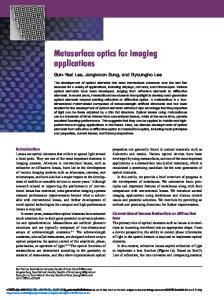New opportunities for metalenses in imaging applications
- PDF / 167,205 Bytes
- 2 Pages / 595.276 x 793.701 pts Page_size
- 65 Downloads / 389 Views
gust 2020 Vol. 63 No. 8: 284231 https://doi.org/10.1007/s11433-020-1561-0
Special Topic: Metasurfaces of Novel Designs and Functionalities
New opportunities for metalenses in imaging applications *
Tao Li
National Laboratory of Solid State Microstructures, College of Engineering and Applied Sciences, Nanjing University, Nanjing 210093, China Received March 3, 2020; accepted April 14, 2020; published online May 9, 2020
Citation:
T. Li, New opportunities for metalenses in imaging applications, Sci. China-Phys. Mech. Astron. 63, 284231 (2020), https://doi.org/10.1007/s11433020-1561-0
Metasurfaces are two-dimensional metamaterials with unprecedented capabilities for manipulating light through their ultrathin and flat architectures. Originally, metasurfaces employed subwavelength resonators to control the local phase of light. Later, their design was extended to nonresonant geometric (Pancharatnam-Berry) phases and dynamic propagation phases. The constituent materials of metasurfaces have extended from metals to all-dielectric to reduce the losses. Metasurfaces have provided numerous functionalities such as beam engineering, waveplates, polarizers, and holograms [1]. One popular application is metalens imaging, which promises extremely wide uses in optical systems [2]. Although the imaging performances of metalenses (e.g., efficiency, working bandwidth, field of view) have been improved by various methods, they are usually constrained by each other. Therefore, the comprehensive performance of today’s metalenses is still inferior to the traditional refraction lenses and compound lenses. Several good reviews have summarized recent progress on the design principles, performances, and applications of metasurfaces and metalenses [1,3]. The details will be omitted here. Instead, I discuss the application advantages of metalens technology, which is advancing rapidly. Metalenses offer two major advantages in imaging technology. First, their ultrathin, ultralight, and flat architectures favor minimization and compact devices. Second, their function multiplexing and expansion abilities provide extremely flexible wavefront shaping, polarization control, and spectrum tai*Corresponding author (email: [email protected])
loring. Unfortunately, in many previous works, metalenses were employed only as substitutes of traditional elements in complex optical systems, which still require additional components such as tube lenses, polarizers, and waveplates [1-3]. Therefore, the sizes and weights of whole imaging systems based on metalenses are seldom reduced, meaning that the core advantages of metalenses (ultra-lightweight and ultra-thin) are not exploited. Nevertheless, some exciting advances toward compact device applications have been made. Recent examples are metasurface spectrometry, eyepieces for augmented reality, and compact polarization cameras. Some compact devices have been inspired by living organisms such as jumping spiders and the compound eyes of insects. Although these devices do not reach the miniaturization level of
Data Loading...











